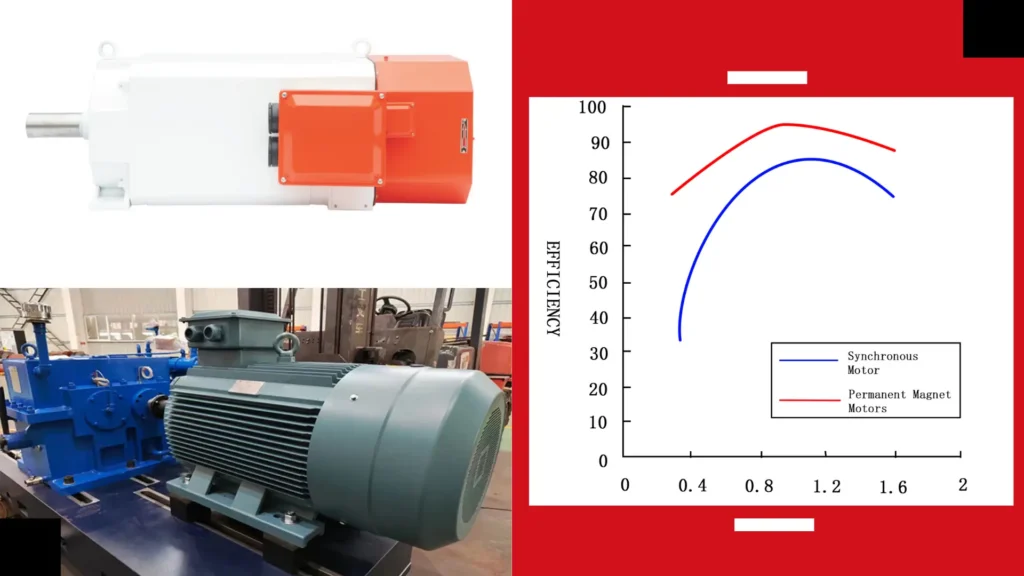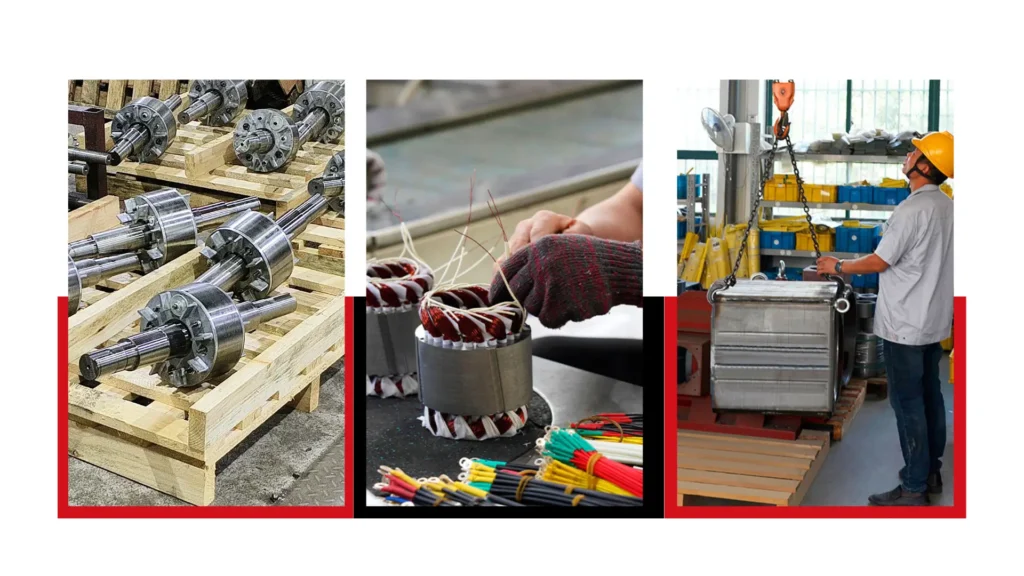The energy transition towards renewable sources is imperative for a sustainable future.
Among these sources, wind energy stands out due to its abundance and efficiency.
As technology advances, the integration of rare earth permanent magnet synchronous (PMS) motors into wind turbines is transforming the industry.
This article will delve into how these innovative motors are revolutionizing wind turbine technology.
What Makes Rare Earth PMS Motors Unique?
The Science Behind PMS Motors
Permanent Magnet Synchronous Motors utilize magnets to produce constant magnetic fields, which enhances performance and efficiency compared to conventional motors.
This technology allows for smooth operation and high torque at low speeds, making it beneficial for applications where precision is essential.
Furthermore, the absence of slip in PMS motors results in reduced energy loss, contributing to overall energy savings and lower operational costs throughout their lifespan.

Benefits of Using Rare Earths in Motors
Integrating rare earth elements results in motors with high torque density, improved efficiency, and lower operational costs, making them ideal for modern wind turbine applications.
The high torque density allows for smaller motor designs without sacrificing performance, leading to more efficient energy use.
Additionally, the improved efficiency translates into lower energy consumption, which can significantly cut down operational costs over time, benefiting both operators and the environment.
How Does It Impact Motor Size?
The use of rare earth materials allows for smaller, lighter motors without compromising performance, leading to more compact wind turbine designs.
This reduction in size and weight means that turbines can be installed in areas where space is limited, maximizing the use of available land.
Moreover, lighter motors can lead to simplified installation processes and reduced transportation costs, contributing to a more streamlined operational approach in wind energy projects.
Why Are Wind Turbines Essential for Renewable Energy?
Clean Energy Generation
Wind turbines harness natural wind energy, transforming it into clean electricity, thus contributing to reducing greenhouse gas emissions.
By utilizing a renewable resource, wind energy helps mitigate the environmental impacts associated with fossil fuel consumption.
This clean energy generation is critical in efforts to combat climate change and promote a sustainable future for generations to come.
Job Creation in the Renewable Sector
The expansion of wind energy leads to the creation of numerous jobs in manufacturing, installation, and maintenance of wind turbine systems.
These job opportunities range from technical positions to skilled labor, fostering economic growth in local communities.
As the sector continues to grow, it also supports educational and training programs that prepare the workforce for careers in renewable energy, ensuring long-term job sustainability.

Energy Independence
By investing in wind energy, countries can decrease their reliance on fossil fuels and enhance energy security.
This shift not only diversifies the energy mix but also stabilizes prices that may fluctuate due to geopolitical tensions or market changes.
Energy independence contributes to national security by reducing vulnerability to external energy pressures and promoting self-sufficiency in energy production.
Sustainable Economic Growth
The wind energy sector drives economic growth through investments and infrastructure development, leading to long-term sustainability.
Financing renewable projects stimulates various industries such as construction, technology, and transportation, generating substantial economic activity.
Additionally, the transition to renewable energy aligns with global sustainability goals, encouraging innovation and fostering a future-focused economy that prioritizes environmental stewardship.
How Do Rare Earth PMS Motors Enhance Wind Turbine Efficiency?
Improved Energy Conversion
Rare earth PMS motors convert wind energy to electrical energy more efficiently, maximizing output even in low-wind conditions.
This efficiency stems from the high-quality magnetic materials used in the motors, which allow for greater torque production and better energy utilization.
Consequently, wind turbines equipped with rare earth PMS motors can achieve higher energy yields, making them more viable in regions where wind speeds are variable or less intense.
Reduced Maintenance Requirements
These motors have fewer moving parts, which translates to lower maintenance costs and increased reliability for wind turbine operators.
The simplicity of their design minimizes wear and tear, leading to significantly reduced downtime for repairs and servicing.
This reliability not only translates into cost savings but also enhances the overall operational efficiency of wind farms, allowing them to generate electricity consistently without unexpected interruptions.

Longevity and Durability
The robust design of rare earth motors ensures a longer lifespan, reducing the need for frequent replacements and minimizing waste.
Constructed with high-quality materials, these motors can withstand extreme weather conditions, ensuring they remain operational over many years.
This longevity helps companies defer costs related to motor replacement and disposal, thus contributing to more sustainable practices in the renewable energy sector.
Optimal Performance in Various Conditions
These motors maintain high performance across a wide range of environmental conditions, ensuring consistent electricity generation.
They are engineered to operate efficiently whether in high winds or calm conditions, adapting their operations to maximize energy capture.
This versatility makes them particularly valuable in diverse geographical regions, where wind patterns may vary significantly throughout the year.
What Role Does Technology Play in Wind Energy?
Smart Grid Integration
The latest technological advancements allow wind energy to be integrated into smart grids, enabling efficient distribution and consumption of electricity.
Smart grids use digital communication technology to monitor and manage the flow of electricity, ensuring it is delivered where and when it is needed most.
This integration not only improves the reliability of the energy supply but also allows for the incorporation of more renewable energy sources, thus reducing reliance on fossil fuels.
IoT and Data Analytics
The Internet of Things (IoT) and data analytics enhance the monitoring and maintenance of wind turbines, ensuring optimal performance and quick response to issues.
Sensors embedded in wind turbines collect real-time data on performance metrics, allowing operators to proactively address maintenance needs before they escalate into larger problems.
By analyzing this data, operators can identify patterns and make informed decisions to improve efficiency and productivity across their wind energy portfolio.

Advanced Materials and Designs
Innovative materials and aerodynamics are improving turbine designs, allowing for higher energy capture and efficiency.
Lightweight and durable materials reduce the overall weight of turbines, increasing their structural efficiency and enabling them to function well even in high-wind conditions.
Furthermore, advancements in aerodynamics allow blades to be designed for optimal airflow, which maximizes energy extraction and enhances overall turbine performance.
Future Technologies on the Horizon
Emerging technologies like floating wind turbines promise to unlock new potential in harnessing wind energy offshore.
These innovative structures can be deployed in deeper waters where wind conditions are more favorable, significantly expanding the geographic range for wind energy production.
The development of floating platforms means that even previously unreachable energy resources can now be tapped into, presenting a vast opportunity for future energy generation and sustainability.
What Are the Economic Implications of Using Rare Earth PMS Motors?
Cost-Effectiveness Over Time
While initial investments may be higher, the long-term savings in maintenance and operational costs make rare earth PMS motors a smart financial choice.
These motors are designed with fewer mechanical parts, which not only reduces wear and tear but also lowers repair frequency.
Additionally, their efficiency translates into better energy output, meaning that operators can generate more electricity with less operational downtime, ultimately maximizing returns on investment over time.
Support for Local Economies
The demand for rare earth materials can lead to the growth of local economies where mining and processing take place.
As these activities increase, jobs are created in various sectors, including mining, transportation, and manufacturing, thus boosting the economic landscape of the region.
Furthermore, local businesses may benefit from increased demand for goods and services tied to the supply chain of rare earth minerals, fostering a ripple effect that promotes broader economic stability and growth.

Attracting Investment
Innovative technologies often attract investments, further boosting the renewable energy sector.
Investors are increasingly interested in projects that harness cutting-edge technologies, as they promise higher returns and sustainability goals.
This influx of capital can lead to improved research and development opportunities, helping manufacturers refine their processes and produce even more advanced PMS motors to meet the growing demand for renewable energy solutions.
Potential for Export
Countries leading in rare earth production and PMS motor technology can position themselves as global leaders in renewable energy.
By exporting both rare earth materials and advanced technologies, these nations can strengthen their economic standing internationally.
Additionally, becoming a hub for such industries can attract further trade, partnerships, and collaborations, fostering a global network that supports sustainable practices and renewable energy initiatives.
Also Read:
How to Mitigate Risks When Sourcing Rare Earth PMS Motors Globally
How Does the Future of Wind Energy Look?
Increased Adoption Rates
As technologies improve and become cost-effective, the adoption of wind energy is expected to rise significantly in the coming years.
The declining cost of wind turbine installation and maintenance makes wind energy an increasingly attractive option for utilities and private investors alike.
With the global focus on reducing carbon emissions and transitioning to greener energy sources, it is anticipated that wind power will play an essential role in meeting future energy demands.
Regulatory Support
Governments worldwide are providing policies and incentives to encourage the shift towards renewable energy sources, including wind power.
These measures include tax credits, grants, and subsidies that lower the financial barrier for implementing wind energy projects.
As regulations supporting renewable energy become more robust, businesses are more likely to invest in wind energy systems, knowing they will benefit from a favorable policy environment.

Innovations in Energy Storage
Advancements in energy storage solutions will complement wind energy, making it more reliable and accessible.
Improved battery technology and innovative storage systems allow for the energy generated by wind turbines to be stored and used when demand is high, even when wind conditions are not optimal.
This synergy between generation and storage will enable wind energy to contribute more significantly to the energy grid, enhancing overall energy stability.
Global Collaboration
International partnerships in research and development can accelerate innovations in the wind energy sector.
By pooling resources and knowledge, countries can lead transformative projects that enhance turbine technology, efficiency, and grid integration.
Such collaborations also create a platform for sharing best practices, regulatory frameworks, and technological advancements that are crucial for scaling up wind energy globally and addressing common challenges in the renewable sector.
Conclusion
The integration of rare earth PMS motors in wind turbines marks a significant advancement in renewable energy technology.
By enhancing efficiency, reducing costs, and contributing to sustainable development, these motors are not just revolutionizing wind turbines but are also paving the way for a greener future.
As the world continues to embrace renewable energy, the role of these innovative motors will become increasingly vital in achieving a sustainable energy landscape.


